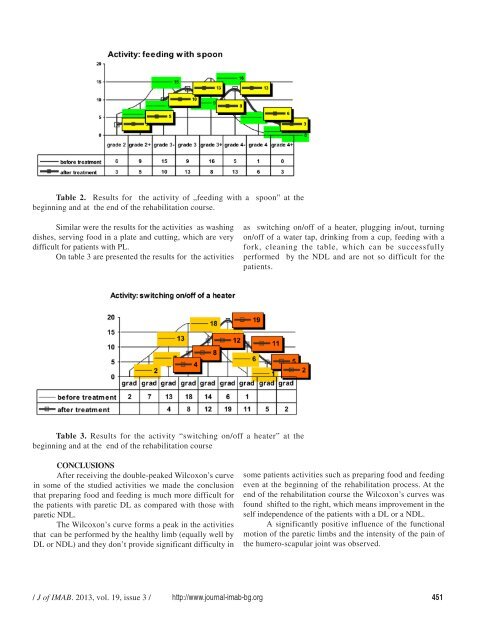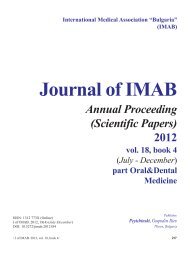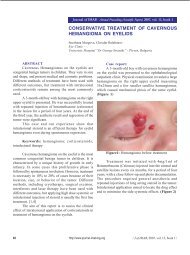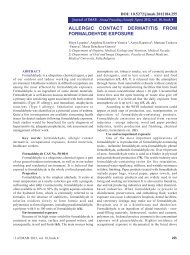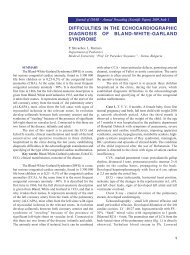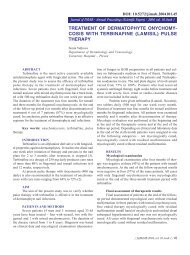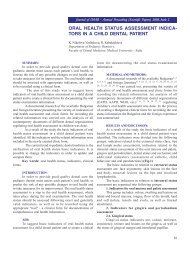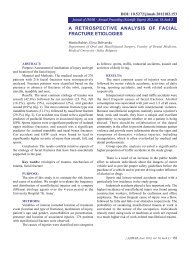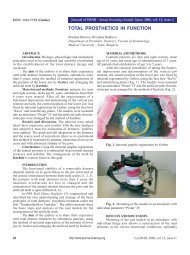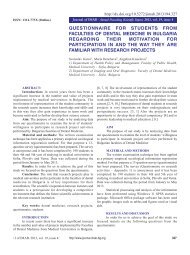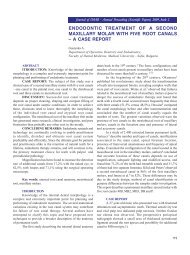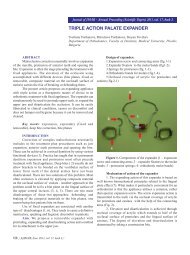Table 2. Results for the activity of „feeding with a spoon” at thebeginning and at the end of the rehabilitation course.Similar were the results for the activities as washingdishes, serving food in a plate and cutting, which are verydifficult for patients with PL.On table 3 are presented the results for the activitiesas switching on/off of a heater, plugging in/out, turningon/off of a water tap, drinking from a cup, feeding with afork, cleaning the table, which can be successfullyperformed by the NDL and are not so difficult for thepatients.Table 3. Results for the activity “switching on/off a heater” at thebeginning and at the end of the rehabilitation courseCONCLUSIONSAfter receiving the double-peaked Wilcoxon’s curvein some of the studied activities we made the conclusionthat preparing food and feeding is much more difficult forthe patients with paretic DL as compared with those withparetic NDL.The Wilcoxon’s curve forms a peak in the activitiesthat can be performed by the healthy limb (equally well byDL or NDL) and they don’t provide significant difficulty insome patients activities such as preparing food and feedingeven at the beginning of the rehabilitation process. At theend of the rehabilitation course the Wilcoxon’s curves wasfound shifted to the right, which means improvement in theself independence of the patients with a DL or a NDL.A significantly positive influence of the functionalmotion of the paretic limbs and the intensity of the pain ofthe humero-scapular joint was observed./ J of IMAB. 2013, vol. 19, issue 3 / http://www.journal-imab-bg.org 451
SUMMARYEarly initiation of the rehabilitation including labouractivities and elements of ADL, given as instructions is ofsignificant importance for achieving better results in therehabilitation course of patients suffering from CVD and forenhancing their ability of self service. Functional OTstimulates the independence of patients and facilitates theprocess of recovery to independent everyday life and socialactivities.REFERENCES:1. Yiancheva S, Milanov I, GeorgievD, Shotekov P. Motor activity. In:Yiancheva S, (ed) Neurology - Generalneurology. Stara Zagora: College, 1998.[in Bulgarian]2. Kaplan EY, Tsirenjapova OD,Shantanova LN. Optimization of theadaptive processes of the organism. M.,Nauka. 1990; 94p. [in Russian]3. Pedretti LW, Early MB. (2001).Occupational therapy: Practice skillsfor physical dysfunction. (5th ed.) St.Louis, MO: Mosby.4. Radomski MV, Trombly CA.Occupational Therapy for PhysicalDysfunction. Baltimore, MD [etc.]Wolters Kluwer/Lippincott Williams &Wilkins, 2008.5. Gencheva N. Classificationalsystem for manual capacity (MAGS) inchildren with cerebral palsy. Sport iNauka, 2011; 1: 60 - 65. [in Bulgarian]6. Mihaylova N. OccupationalTherapy in some degenerative diseasesof the motor support apparatus. - In:Topuzov I, (ed) Occupational Therapy:2nd part. Sofia: RIK „Simel”, 2008; 153-155. [in Bulgarian]7. Petkova I. Interactive methods ineducators’ qualification, Qualyeducayion for all through improvingteacher training. Paradigma, 2010; 214-216. [in Bulgarian]8. Punwar AJ, Peloquin SM.Occupational Therapy: Principles andPractice. 3rd edn. Lippincott Williams &Wilkins, 2000; pp.303.9. Delank H. Neurology. Sofia: MI„Sharov”, 1996. [in Bulgarian]10. Sinaki M. Basic clinicalrehabilitation medicine. Toronto –Philadelphia: W. B. Saunders Co, 1987.11. Slanchev P, Bonev L, Bankov St.Textbook on Kinesitherapy. Medicina iphyscultura, Sofia. 1986. [in Bulgarian]12. Karaneshev G, Milcheva D.Methods for diagnostics andexamination in remedial gymnastics.Sofia: National Sport Academy, 1984. [inBulgarian]13. Hannecke van Bruggen. Occupationaltherapy (ergotherapy) - philosophy,objectives and methodology.Rehabilitation Medicine and the Qualityof Life, 2007; 2:16.14. Kielhofner G. (ed.) (2008)Model of human occupation: theoryand application, 4th edn. LippincottWilliams & Wilkins.15. Busarov St. Basis of themedicine-social rehabilitation. Sofia:Medicina i physcultura, 1982. [inBulgarian]16. Koleva I. Physical analgesia inneurological diseases. Cephalgia, 2006;8(1):10-21. [in Bulgarian]17. Mollova K, Paskaleva R.Rehabilitation activities in patients withmotor dosturbancer. Collection ofmaterials. International cientificconferention; Stara Zagora,s bads, 2009.[in Bulgarian]18. Rusk HA. RehabilitationMedicine: A Textbook on PhysicalMedicine and Rehabilitation, 2nd Edn,Mosby Co, St. Louis. 1964. 668 pp.19. AOTA Council on Standards.Occupational therapy – its definitionand function. Amer. J. Occup. Therapy,1972; (26): 204-205.20. Hansen RA, Atchison B.Conditions in Occupational Therapy.Baltimore: Williams & Wilkins, 1993.21. Topuzov I. OccupationalTherapy. 3rd part; Sofia: RIK „Simel”.2009. [in Bulgarian]Address for correspondence:Danelina Vacheva, PhDkinesitherapist, Clinic for physical medicine and rehabilitationUMHAT “Dr. G. Stranski” Pleven,8A, Gerge Kochev str., Pleven, BulgariaE-mail: danelina@abv.bg452 http://www.journal-imab-bg.org / J of IMAB. 2013, vol. 19, issue 3 /


